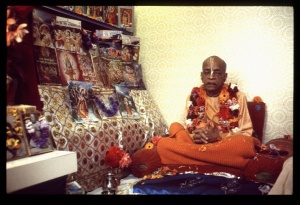CC Adi 5.40 (1975)

A.C. Bhaktivedanta Swami Prabhupada
TEXT 40
- sei para-vyome nārāyaṇera cāri pāśe
- dvārakā-catur-vyūhera dvitīya prakāśe
SYNONYMS
sei—that; para-vyome—in the spiritual sky; nārāyaṇera—of Lord Nārāyaṇa; cāri pāśe—on four sides; dvārakā—Dvārakā; catur-vyūhera—of the quadruple expansions; dvitīya—the second; prakāśe—manifestation.
TRANSLATION
In that spiritual sky, on the four sides of Nārāyaṇa, are the second expansions of the quadruple expansions of Dvārakā.
PURPORT
Within the spiritual sky is a second manifestation of the quadruple forms of Dvārakā from the abode of Kṛṣṇa. Among these forms, which are all spiritual and immune to the material modes, Śrī Baladeva is represented as Mahā-saṅkarṣaṇa.
The actions in the spiritual sky are manifested by the internal potency in pure spiritual existence. They expand in six transcendental opulences, which are all manifestations of Mahā-saṅkarṣaṇa, who is the ultimate reservoir and objective of all living entities. Although belonging to the marginal potency known as jīva-śakti, the spiritual sparks known as the living entities are subjected to the conditions of material energy. It is because these sparks are related with both the internal and external potencies of the Lord that they are known as belonging to the marginal potency.
In considering the quadruple forms of the absolute Personality of Godhead, known as Vāsudeva, Saṅkarṣaṇa, Pradyumna and Aniruddha, the impersonalists, headed by Śrīpāda Śaṅkarācārya, have interpreted the aphorisms of the Vedānta-sūtra in a way suitable for the impersonalist school. To provide the intrinsic import of such aphorisms, however, Śrīla Rūpa Gosvāmī, the leader of the six Gosvāmīs of Vṛndāvana, has properly replied to the impersonalists in his Laghu-bhāgavatāmṛta, which is a natural commentary on the aphorisms of the Vedānta-sūtra.
The Padma Purāṇa, as quoted by Śrīla Rūpa Gosvāmī in his Laghu-bhāgavatāmṛta, describes that in the spiritual sky there are four directions, corresponding to east, west, north and south, in which Vāsudeva, Saṅkarṣaṇa, Aniruddha and Pradyumna are situated. The same forms are also situated in the material sky. The Padma Purāṇa also describes a place in the spiritual sky known as Vedavatī-pura, where Vāsudeva resides. In Viṣṇuloka, which is above Satyaloka, Saṅkarṣaṇa resides. Mahā-saṅkarṣaṇa is another name of Saṅkarṣaṇa. Pradyumna lives in Dvārakā-pura, and Aniruddha lies on the eternal bed of Śeṣa, generally known as ananta-śayyā, on the island called Śvetadvīpa, in the ocean of milk.